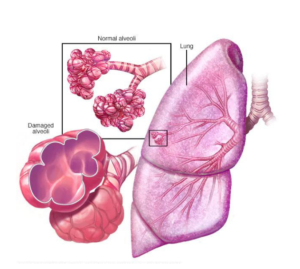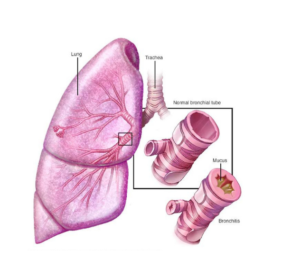Chronic obstructive pulmonary disease (COPD) is a chronic inflammatory lung disease that causes obstruction of air flow from the lungs. Symptoms include difficulty breathing, coughing, mucus (phlegm) production, and wheezing. It is usually caused by long-term exposure to irritating gases or particles, often from cigarette smoke. People with COPD are at increased risk of heart disease, lung cancer, and a variety of other conditions.
Overview
Emphysema and chronic bronchitis are the two most common conditions that contribute to COPD. These two conditions usually occur together and can vary in severity among individuals with COPD.
Chronic bronchitis is inflammation of the lining of the bronchi that carry air to and from the air sacs (alveoli) in the lungs. It is characterized by a daily cough and the production of mucus (sputum).
Emphysema is a condition in which the air sacs at the end of the smallest air passages (bronchioles) in the lungs are destroyed as a result of harmful exposure to cigarette smoke, other irritating gases and particulates.
Although COPD is a progressive disease that gets worse over time, COPD can be treated. With proper management, most people with COPD can achieve good symptom control and quality of life, as well as reduce the risk of other associated conditions.
Symptoms
COPD symptoms often do not appear until after significant lung damage has occurred, and they usually worsen over time, especially if exposure to smoking continues.
COPD signs and symptoms may include:
- Shortness of breath, especially during physical activities
- whistling sadness
- A chronic cough that may produce mucus (phlegm) that may be clear, white, yellow, or greenish
- Frequent respiratory infections
- Frequent respiratory infections
- Unintended weight loss (in later stages)
- Swelling in the ankles, feet or legs
People with COPD are also more likely to have episodes called exacerbations, during which their symptoms become worse than normal daily changes and last at least several days.
When to see a Doctor/Teleconsultation
Usually You Need to Consult Specialist When you Feel the Symptoms but Seek immediate medical care if you can’t catch your breath, if you experience severe blueness of your lips or fingernail beds (cyanosis) or a rapid heartbeat, or if you feel foggy and have trouble concentrating.
Causes
The main cause of COPD in developed countries is tobacco smoking. In the developing world, COPD often occurs in people exposed to fumes from burning fuel for cooking and heating in poorly ventilated homes.
Only some chronic smokers develop clinically apparent COPD, although many smokers with long smoking histories may develop reduced lung function. Some smokers develop less common lung conditions. They may be misdiagnosed as having COPD until a more thorough evaluation is performed.
How your lungs are affected
Air travels down your windpipe (trachea) and into your lungs through two large tubes (bronchi). Inside your lungs, these tubes divide many times — like the branches of a tree — into many smaller tubes (bronchioles) that end in clusters of tiny air sacs (alveoli).
The air sacs have very thin walls full of tiny blood vessels (capillaries). The oxygen in the air you inhale passes into these blood vessels and enters your bloodstream. At the same time, carbon dioxide — a gas that is a waste product of metabolism — is exhaled.
Your lungs rely on the natural elasticity of the bronchial tubes and air sacs to force air out of your body. COPD causes them to lose their elasticity and over-expand, which leaves some air trapped in your lungs when you exhale.
Causes of airway obstruction
Causes of airway obstruction include:
- Emphysema. This lung disease causes destruction of the fragile walls and elastic fibers of the alveoli. Small airways collapse when you exhale, impairing airflow out of your lungs.
- Chronic bronchitis. In this condition, your bronchial tubes become inflamed and narrowed and your lungs produce more mucus, which can further block the narrowed tubes. You develop a chronic cough trying to clear your airways.

Cigarette smoke and other irritants
- In the vast majority of people with COPD, the lung damage that leads to COPD is caused by long-term cigarette smoking. But there are likely other factors at play in the development of COPD, such as a genetic susceptibility to the disease, because not all smokers develop COPD.

Prevention
Unlike some diseases, COPD typically has a clear cause and a clear path of prevention, and there are ways to slow the progression of the disease. The majority of cases are directly related to cigarette smoking, and the best way to prevent COPD is to never smoke — or to stop smoking now.
If you’re a longtime smoker, these simple statements may not seem so simple, especially if you’ve tried quitting — once, twice or many times before. But keep trying to quit. It’s critical to find a tobacco cessation program that can help you quit for good. It’s your best chance for reducing damage to your lungs.
Occupational exposure to chemical fumes and dusts is another risk factor for COPD. If you work with these types of lung irritants, talk to your supervisor about the best ways to protect yourself, such as using respiratory protective equipment.
Here are some steps you can take to help prevent complications associated with COPD:
- Quit smoking to help reduce your risk of heart disease and lung cancer.
- Get an annual flu vaccination and regular vaccination against pneumococcal pneumonia to reduce your risk of or prevent some infections.
- Talk to your doctor if you feel sad or helpless or think that you may be experiencing depression.